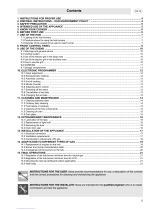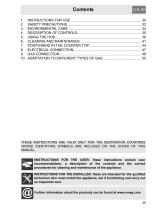
Table of Contents
1. Instructions for proper use ................................................................................................................................. 4
2. DISPOSAL INSTRUCTIONS – OUR ENVIRONMENT POLICY ........................................................................... 5
3. AVERTISSEMENTS POUR LA SÉCURITÉ .......................................................................................................... 6
4. INTENDED USE OF THE APPLIANCE ................................................................................................................ 6
5. GETTING TO KNOW YOUR APPLIANCE ............................................................................................................ 7
6. BEFORE FIRST USE ............................................................................................................................................ 7
7. FRONT CONTROL PANEL ................................................................................................................................... 8
8. USE OF THE HOB ............................................................................................................................................... 10
8.1 Lighting of the hob burners ................................................................................................................................................10
8.2 Practical advice for using the hob burners .........................................................................................................................10
8.3 Diameter of the vessels to be used on each burner ..........................................................................................................10
9. USE OF THE OVEN ............................................................................................................................................ 11
9.1 Warnings and general advice ............................................................................................................................................11
9.2 Cooling system ..................................................................................................................................................................11
9.3 Use of the electric grill .......................................................................................................................................................11
9.4 How to use the grill ............................................................................................................................................................12
9.5 Warning ..............................................................................................................................................................................12
9.6 Storage compartment ........................................................................................................................................................12
10. AVAILABLE ACCESSORIES ........................................................................................................................... 13
11. ELECTRONIC PROGRAMMER ....................................................................................................................... 14
11.1 Clock adjustment .............................................................................................................................................................14
11.2 Semiautomatic cooking ....................................................................................................................................................14
11.3 Automatic cooking ...........................................................................................................................................................14
11.4 End of cooking .................................................................................................................................................................14
11.5 Minute Counter ................................................................................................................................................................15
11.6 Adjusting alarm volume ...................................................................................................................................................15
11.7 Switching off the alarm ....................................................................................................................................................15
11.8 Cancellation of set data ...................................................................................................................................................15
11.9 Changing the set data ......................................................................................................................................................15
12. CLEANING AND MAINTENANCE .................................................................................................................... 16
12.1 Cleaning stainless steel ...................................................................................................................................................16
12.2 Ordinary daily cleaning ....................................................................................................................................................16
12.3 Food stains or residues ...................................................................................................................................................16
12.4 Cleaning of the hob components .....................................................................................................................................16
12.5 Cleaning of oven ..............................................................................................................................................................16
12.6 Door glass ........................................................................................................................................................................17
12.7 Pyrolysis: automatic oven cleaning ..................................................................................................................................17
12.8 Before starting the automatic cleaning cycle ...................................................................................................................17
12.9 Programming the automatic cleaning cycle .....................................................................................................................18
13. EXTRAORDINARY MAINTENANCE ................................................................................................................ 19
13.1 Lubrication of the taps .....................................................................................................................................................19
13.2 Replacement of light bulb ................................................................................................................................................19
13.3 Removing the door ..........................................................................................................................................................19
13.4 Oven door joint ................................................................................................................................................................19
14. INSTALLING THE APPLIANCE ........................................................................................................................ 20
14.1 Electrical connection ........................................................................................................................................................20
14.2 Ventilation requirements ..................................................................................................................................................21
14.3 Combustion gas discharge ..............................................................................................................................................21
14.4 Connecting to natural and LPG gas .................................................................................................................................21
15. ADAPTATION TO DIFFERENT TYPES OF GAS ............................................................................................. 22
15.1 Replacement of nozzles on the hob ................................................................................................................................22
15.2 Burner and nozzle characteristics table ...........................................................................................................................23
15.3 Arrangement of the burners on the hob ...........................................................................................................................23
16. FINAL OPERATIONS ........................................................................................................................................ 24
16.1 Regulation of the hob burner minimum level for natural gas ...........................................................................................24
16.2 Regulation of the hob burner minimum level for LPG ......................................................................................................24
16.3 Mounting the rear top skirtboard (where applicable) .......................................................................................................24
16.4 Wall fixing ........................................................................................................................................................................24
INSTRUCTIONS FOR THE USER: these contain recommendations for use, a description of
the controls and the correct procedures for the cleaning and maintenance of the appliance.
INSTRUCTIONS FOR THE INSTALLER: these are intended for the qualified technician who is to carry
out appropriate checks on the gas supply and is to install, commission and test the appliance.
3





















